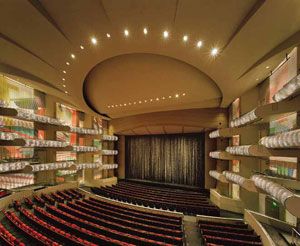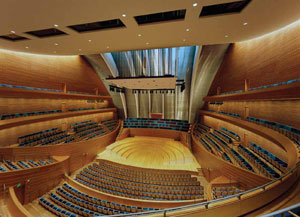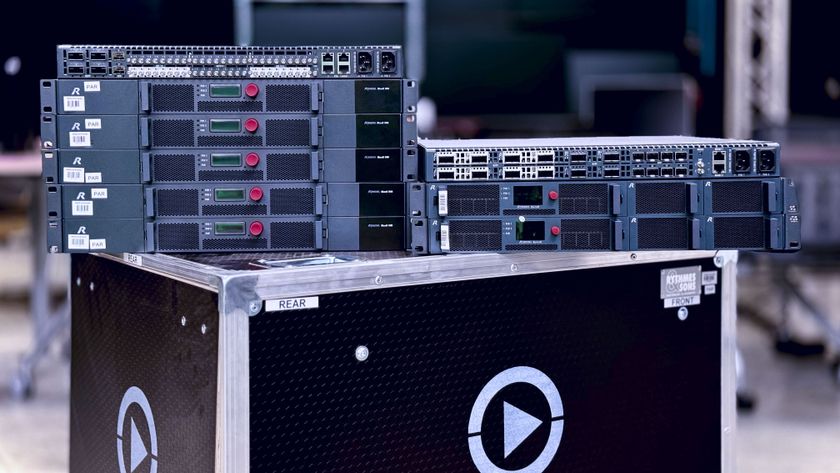Technology Maintains Balance with Soaring Channel Counts in Performing Arts Applications
Both the Muriel Kauffman Theatre and Helzberg Hall (pictured) at the Kauffman Center for the Performing Arts in Kansas City, MO have dedicated Sennheiser wireless microphone systems that, if necessary, can be used in the other facility.
If all the world’s a stage, there must be a lot of wireless microphones out there. As a number of performing arts venues open their newly minted doors, they make their way through a crowded RF space with a little help from the latest technology.
“The FCC has sent a clear message to our industry that we must learn to efficiently use the RF space that is available,” said Mark Donovan, sales engineer of installed sound with Audio-Technica. “This is not really news as we have seen these changes coming. The fact that the FCC has recognized the need for wireless microphones is a small victory in itself, and they have made it clear that we will be allowed to continue to operate, but we must do so within their rules. All of the wireless manufacturers are working to develop products that will be useable in this new landscape.”
Two main factors are helping to achieve higher channel counts, said Chris Lyons, manager of educational and technical communications with Shure. “One is systems per megahertz; the number of systems you can squeeze into one TV channel of spectrum is increasing. It’s now up to 13, so systems have become able to work when spaced more closely together.”
In addition, monitoring and control software available with higher end systems makes it easier to plan the number of systems, to do a scan of spectrum, to find the best gaps, and to ensure that frequencies are compatible. “Sometimes,” Lyons continued, “this also takes into account other RF devices such as intercoms, walkie-talkies, and in-ear monitoring systems.”
The free and simple-to-use software makes it easy for a venue to take more command of planning systems and do more with spectrum they have. “This is especially important in crowded areas where there may be a number of clustered theaters, not only within a complex, but next door or across the street,” Lyons added. “The software indicates which signals are bleeding into a venue from outside and must be avoided. Many times, there are simultaneous events going on, and we all have to play friendly.”

Shure’s UR1M micro-bodypacks were employed throughout the 32nd annual Kennedy Center Honors event two years ago. Shure’s standard UR1 bodypacks also came into play, for a unique arrangement of choir mics.
Actually, channel counts for new venues vary widely, explained Karl Winkler, director of business development, Lectrosonics. “Some well-known venues only have 12 channels, while others need 48. Often, what we see is that new venues will purchase a modest channel count to cover the bread-and-butter bookings, while for larger shows, additional wireless units will be rented in.”
To deal with the existing crowded spectrum, frequency coordination should be done with a newly installed wireless system and then again on a fairly regular basis since the spectrum is continuing to change, he said. “There are software packages available such as RF Guru and IAS that can make this a relatively painless task with confidence-building results. Most current wireless systems offer spectrum scanning as well. “
The latest crop of wireless microphones has smarter technology such as digital and digital hybrid transmission schemes that help to minimize the effects of interference while providing better sound quality than previous systems. “Another feature on several current wireless systems that can help with highchannel count locations, particularly where there may be multiple venues within a single facility, is variable RF power,” Winkler added. “Low power can be helpful in these cases. However, upping the RF power can also help to overcome external interference sources.”
Curtain Call
“The performance environment has always had a need for wireless microphones. However, technology capabilities and cost have been considerable factors that managed the number of channels usually found in all but the most high-end productions,” said Martin Van Dijk, a senior consultant with Engineering Harmonics (EH), in Toronto, ON, Canada. EH’s projects include the recently opened Kauffman Center for the Performing Arts in Kansas City, MO.
“The Kauffman Center is unique in that there are two performance venues in one facility—a proscenium theater and a concert hall,” Van Dijk said. “The wireless microphone systems used in this facility are quite straightforward. Each facility has dedicated units that, if necessary, can be used in the other facility. Therefore, the wireless units are from the same manufacturer, Sennheiser. The channels are organized so they do not interfere with each other when used. The facility also permits wireless to be used in the lobby space, which is like a grand performance space in itself.”
In the past, production personnel had to weigh costs and consider the risk of a technology failure on the event, he said. “Today, these issues remain far less of a consideration than in previous generations of wireless product. The technology has become more affordable and the number of channels found in a given production has increased. Generally, the number of wireless channels has increased on a music production because of in-ear monitor systems.”

In the past, production personnel had to weigh costs and consider the risk of a technology failure on the event, observed Martin Van Dijk of Engineering Harmonics, which designed systems for the Muriel Kauffman Theatre (pictured) and the other performance spaces at the Kauffman Center for the Performing Arts. But “today these issues remain far less of a consideration than in previous generations of wireless product.”
And some manufacturers have added sophisticated feature sets that not only improve performance, but also enable the trained technician to install and operate wireless systems more effectively. “Tools integrated into the wireless products allow technicians to actually organize their wireless packages as systems,” Van Dijk added. “Very useful software features which permit scanning of the local RF spectrum, create channel assignments, and monitor battery life are just a few of the features integrated into the wireless products which empower the technician to deliver a solid wireless performance.”
In the last 20 years the market has seen significant channel count changes, said Shure’s Lyons. “In the early and mid-’90s there was an explosion of rock-driven musicals with amplified music that necessitated a shift in the way performers were mic’d. There was a move to head-worn mics to compete with the music. This was most important for these shows with large casts, where everyone onstage was of equal importance. Instead of 15 wireless systems they now had 30.”
The creativity of sound designers has contributed to the increased channel count as well. “They have found new ways to use wireless outside of the traditional vocal role, such as using them to transmit sound effects and placing them on a piece of the stage set; there are so many novel ways to use mics in spots where it’s hard to run cables,” he added. “This really got started in sports event broadcasts such as basketball, where mics were placed on the hoops. It creates a challenge as clients are demanding more out of wireless and their expectations are firm. They are not willing to tolerate noise or dropouts.”
These exponential channelcount increases have resulted in systems that can provide higher performance and reliability at lower costs from wireless microphone manufacturers, Donovan said. “As we continue to field products to meet these needs, end users are pushing the boundaries and coming up with new ways to use these technologies to enhance their performances.”
New systems have lots of features and capabilities that venues haven’t seen yet, said Lyons. “If the integrator discusses some of these new features, the venue might upgrade. Shure’s Axient system with ShowLink Remote Control lets the operator wirelessly adjust the body pack while the performer is onstage. It also controls transmitter levels, mic gain levels, and on/off functions, all remotely. It also monitors battery conditions offstage so the engineer has complete control without having to rummage under a performer’s costume, and it has rechargeable batteries, which eliminates battery replacement costs.”
At Lectrosonics, the RM remote tool for the SM Series transmitters allows for “no touch” adjustments to the operating parameters. “This is especially important when the transmitter is to be buried in the costume,” Lectrosonics’ Winkler explained. “The Venue receivers are very dense—up to six receivers in a single rack space—which is also popular for space-starved theaters and other venues. Digital Hybrid Wireless, the technology upon which the SM Series transmitters and Venue receivers are built, provides very transparent sound due to the lack of a compander in the audio path. Sound designers have commented to us on how much they appreciate the lack of a ‘wireless sound’ when they hear this equipment.”
Size and Sweat
Tiny sizes, and features such as perspiration-resistant options, are enhancing the wireless landscape.
“Small size, easy concealment, variable RF power, transparent sound quality, toughness, moisture resistance, ease of use, good interface design, and computer control of the receivers are much in demand now,” Winkler said. “For instance, our SM Series transmitters have been gaining in popularity for theater use just for these reasons. Now it is not so difficult to place a transmitter in hidden places on the actors, and have the confidence that you’ll still have a show.”
As performances shift and change to enhance the entertainment experience, manufacturers must rise to the challenge, Audio Technica’s Donovan explained. “These options allow the end user the flexibility required to be truly creative. Our technologies must be provided as tools to support this creative process, and we are constantly seeking input to make these tools available in a timely manner. At Audio-Technica, the need for high-quality miniature headworn microphones prompted us to develop our BP892 MicroSet and BP893 MicroEarset condenser microphones, both of which are offered in wired and wireless models.”
Audio-Technica’s donut-shaped moisture guard for the BP892 MicroSet and BP893 MicroEarset Subminiature Omnidirectional Condenser Headworn Microphones is provided to protect the element from sweat and moisture, positioned as close to the element as possible to provide maximum protection.
“We test our small, perspiration-resistant products using our own formula of artificial sweat,” Lyons said. “The Shure UR1M Micro- Bodypack was developed for the theater market. Its circuit board is dipped in acrylic to make it moisture-resistant.”
A lot of wireless microphone decisions come down to the look of the production itself, Lyons elaborated. “You probably don’t want to see headworn mics on a piece that takes place in the 18th century, for example.”
Smaller size devices are much more attractive to talent in the award presentation/ broadcast environment, Van Dijk said. “Obviously, the more discreet the hardware the better it is for the talent. However, compact size is a challenge, and it is quite remarkable what some manufacturers have developed in terms of the finishes and assemblies. We have seen wireless have to endure some very harsh production environments, and they still work well through the production. Battery life has improved, and the technologies some manufacturers have developed to squeeze every bit of life out of the batteries is a much welcome improvement.”
What Clients Want
Wireless requirements have not changed significantly; clients and users want reliability, compact body packs, long battery life, and high-quality sound. “The challenge is greatest for the manufacturers, as they must continue to deliver on all the requirements, but in an ever-increasingly crowded RF space,” Van Dijk said. “How they accomplish this, and on what technology platform, is a technical challenge that remains with the manufacturers. I don’t believe users are saying it must be ‘a digital system,’ but if that is the only way to deliver the requirements, then the market place will accept the technology as long as it delivers on the performance expectations.”
Many new users are so inundated with wireless technology they have expectations that wireless microphones are readily available and easily deployed, he added. “Unfortunately, through a difficult experience, most users quickly discover there is an enormous difference between the wireless devices they use for convenience and wireless they use for the performance environment.”
What Shure sees happening, Lyons said, especially in the smaller theaters with smaller budgets, is a tendency to under-spec the wireless. “They end up maxing out the system right away, without room for upgrade or growth. Most wireless systems have limited capacity. When the number of possible systems goes up, the cost goes up. A facility that needs 20 channels today should be buying a system that will allow more than that number to operate in the future.”
Margin Builder
“Integrators must position themselves as solution experts as well as product sales people,” said Mark Donovan of Audio-Technica. “The days of throwing up a wireless microphone with a basic pair of antennas are over. Careful RF planning and proper antenna practices will be the key in navigating the new RF landscape. Selling their expertise and services along with the products will allow integrators to maintain or even increase their margins.”
Karen Mitchell is a freelance writer based in Boulder, CO.














